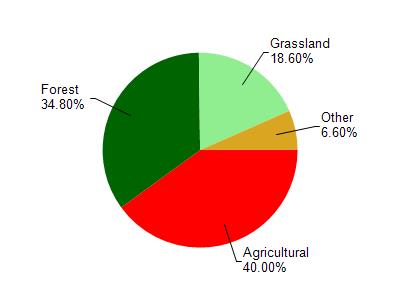Barron, Dunn
No
No
No
Fish and Aquatic Life
Overview
Upper Pine Creek is designated as an outstanding resource water (ORW) above the Dallas Flowage.
The ORW classification prohibits any new point source to discharge effluent containing compounds
in excess of background levels found in Upper Pine Creek. The Pine Creek State Fishery Area is
located above Dallas. Biotic index surveys in the early 1980s indicate very good to excellent water
quality in the trout portions of Upper Pine Creek.
Discharge from the village of Dallas wastewater treatment plant is to Upper Pine Creek below the
flowage. The village of Dallas wastewater treatment plant is an aerated pond system with ultraviolet
disinfection. The discharge presently falls below the 150-pound per month level for requiring
phosphorus removal under NR 217 Wis. Adrn. Code. However, the current permit requires
monthly monitoring in 1998 to gather baseline data on phosphorus loadings from ths facility. A
stream study should be done to assess any potential impacts from this discharge. At one time, the
plant discharged to both surface water and groundwater via a seepage cell. The system was upgraded
to discharge only to surface water and provide adequate disinfection during the term of the previous
permit.
Below Dallas, Upper Pine Creek supports a warm water sport fish community that is degraded by
barnyard or exercise lot runoff and streambank pasturing.
Date 1996
Author Aquatic Biologist
Impaired Waters
The 2018 assessments of Upper Pine Creek (East line S10 T32N R12W to the headwaters) showed biological impairment; new macroinvertebrate sample data exceeded the 2018 WisCALM listing criteria for the Fish and Aquatic Life use (i.e. at least one macroinvertebrate Index of Biotic Integrity (IBI) average scored in the poor condition category). Based on the most updated information, this water was proposed for the impaired waters list.
Date 2017
Author Ashley Beranek
Impaired Waters
Upper Pine Creek (2087300), from the Barron County Line to the East Branch Upper Pine Creek, was assessed during the 2016 listing cycle; total phosphorus sample data overwhelmingly exceed 2016 WisCALM listing thresholds for the Fish and Aquatic Life use, however, available biological data do not indicate impairment (i.e. no macroinvertebrate or fish Index of Biotic Integrity (IBI) scored in the "poor" condition category).
Date 2015
Author Aaron Larson
Condition
Wisconsin has over 84,000 miles of streams, 15,000 lakes and milllions of acres of wetlands. Assessing the condition of this vast amount of water is challenging. The state's water monitoring program uses a media-based, cross-program approach to analyze water condition. An updated monitoring strategy (2015-2020) is now available. Compliance with Clean Water Act fishable, swimmable standards are located in the Executive Summary of Water Condition in 2018. See also the 'monitoring and projects' tab.
Reports
Management Goals
Wisconsin's Water Quality Standards provide qualitative and quantitative goals for waters that are protective of Fishable, Swimmable conditions [Learn more]. Waters that do not meet water quality standards are considered impaired and restoration actions are planned and carried out until the water is once again fishable and swimmable
Management goals can include creation or implementation of a Total Maximum Daily Load analysis, a Nine Key Element Plan, or other restoration work, education and outreach and more. If specific recommendations exist for this water, they will be displayed below online.
Monitoring
Monitoring the condition of a river, stream, or lake includes gathering physical, chemical, biological, and habitat data. Comprehensive studies often gather all these parameters in great detail, while lighter assessment events will involve sampling physical, chemical and biological data such as macroinvertebrates. Aquatic macroinvertebrates and fish communities integrate watershed or catchment condition, providing great insight into overall ecosystem health. Chemical and habitat parameters tell researchers more about human induced problems including contaminated runoff, point source dischargers, or habitat issues that foster or limit the potential of aquatic communities to thrive in a given area. Wisconsin's Water Monitoring Strategy was recenty updated.
Grants and Management Projects
Monitoring Projects
| WBIC | Official Waterbody Name | Station ID | Station Name | Earliest Fieldwork Date | Latest Fieldwork Date | View Station | View Data |
|---|
| 2087300 | Upper Pine Creek | 10008761 | Upper Pine Cr at C. Runkle Property [1] | | | Map | Data |
|

Watershed Characteristics
Upper Pine Creek is located in the Pine Creek and Red Cedar River watershed which is 287.89 mi². Land use in the watershed is primarily agricultural (40%), forest (34.80%) and a mix of grassland (18.60%) and other uses (6.60%). This watershed has 538.68 stream miles, 84.94 lake acres and 12,197.18 wetland acres.
Nonpoint Source Characteristics
This watershed is ranked High for runoff impacts on streams, Low for runoff impacts on lakes and High for runoff impacts on groundwater and therefore has an overall rank of High. This value can be used in ranking the watershed or individual waterbodies for grant funding under state and county programs.However, all waters are affected by diffuse pollutant sources regardless of initial water quality. Applications for specific runoff projects under state or county grant programs may be pursued. For more information, go to surface water program grants.